
Harmonia axyridis is a large lady beetle or ladybug species that is most commonly known as the harlequin, Asian, or multicoloured Asian lady beetle. This is one of the most variable species in the world, with an exceptionally wide range of colour forms. It is native to eastern Asia, but has been artificially introduced to North America and Europe to control aphids and scale insects. It is now common, well known, and spreading in those regions, and has also established in Africa and widely across South America. This species is conspicuous in North America, where it may locally be known as the Halloween beetle, as it often invades homes during October to overwinter.
Coccinella novemnotata, the nine-spotted ladybug or nine-spotted lady beetle or C9, is a species of ladybug in the family Coccinellidae native to North America. This beetle was once ubiquitous across the continent but experienced a sharp and drastic decline around the 1960’s. Now, considered a rare species, the nine-spotted ladybug has received much attention from researchers who wish to understand the causes of its decline and restore the population of this charismatic beetle to benefit from their aphidophagous nature as biocontrol agents in agriculture.

Coccinella septempunctata, the seven-spot ladybird, is a carnivorous beetle native to the Old World and is the most common ladybird in Europe. The beetle is also found in North America, Central and Eastern Asia and regions with a temperate climate. Its elytra are of a red colour, but each punctuated with three black spots, with one further spot being spread over the junction of the two, making a total of seven spots, from which the species derives both its common and scientific names.
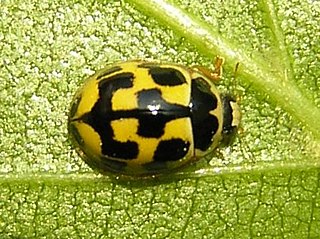
Propylea quatuordecimpunctata is a small lady beetle, belonging to the family Coccinellidae. It is sometimes referred to by the common name 14-spotted ladybird beetle, or simply P-14.

Halyzia sedecimguttata, or orange ladybird, is a species of Coccinellidae (ladybirds) family.
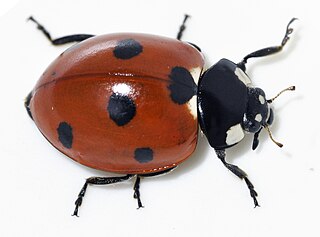
Coccinellidae is a widespread family of small beetles. They are commonly known as ladybugs in North America and ladybirds in the United Kingdom; "lady" refers to mother Mary. Entomologists use the names ladybird beetles or lady beetles to avoid confusion with true bugs. The more than 6,000 described species have a global distribution and are found in a variety of habitats. They are oval beetles with a domed back and flat underside. Many of the species have conspicuous aposematic (warning) colours and patterns, such as red with black spots, that warn potential predators that they taste bad.

Coccinella transversalis, commonly known as the transverse ladybird or transverse lady beetle, is a species of ladybird beetle found from India across southern and southeastern Asia to Malesia and Australia. It is not to be confused with Coccinella transversoguttata, a widespread species in Europe and North America also known as the transverse ladybird. The alternative vernacular of small transverse ladybird may be used for C. transversalis in instances where these two species are discussed together.
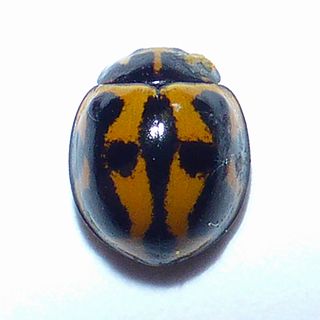
Coelophora inaequalis, the variable ladybird, common Australian lady beetle or common Australian ladybug is a ladybird species endemic to Australia, Oceania and Southern Asia. The variable ladybird gets its name from the black markings on the adult elytra, that vary from one individual to another.

Harmonia conformis, the large spotted ladybird, is a species of ladybird. It has a light reddish appearance and its colouration includes 20 large black spots, 18 of which are found on the elytra. They are quite large for ladybirds, being about 6–7 mm long. It is a predator of other insects, eating aphids as both a larva and imago (adult). It is found in Australia, and has been introduced to New Zealand, where it is common in northern regions. Another member of the same genus, Harmonia antipodum, also occurs in New Zealand. This species, however, is a native and is much smaller and harder to find.

Coccinella leonina, common name orange-spotted ladybird, is a species of ladybird native to New Zealand. It is black with orange spots. A predator species, it is present in a variety of habitats.

Adalia decempunctata, the ten-spotted ladybird or ten-spotted lady beetle, is a carnivorous beetle of the family Coccinellidae.
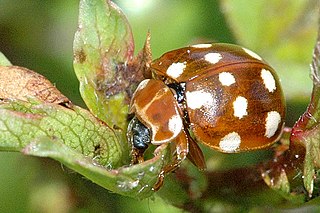
Calvia quatuordecimguttata, the cream-spot ladybird, is a species of ladybird in the family Coccinellidae. Its distribution is holarctic, it being found in Europe and through the East Palearctic to Japan. It is introduced to North America. This ladybird is generally 4 to 5 millimetres in length and varies in appearance depending on the geographical location. It usually lives in hedgerows and deciduous trees.

Coleomegilla maculata, commonly known as the spotted lady beetle, pink spotted lady beetle or twelve-spotted lady beetle, is a large coccinellid beetle native to North America. The adults and larvae feed primarily on aphids and the species has been used as a biological control agent. Based on name connotation and to avoid confusion with other species also called "spotted ladybeetle", spotted pink ladybeetle is probably the most appropriate common name for this species.

Cycloneda sanguinea, also known as the spotless lady beetle, is a widespread species of ladybird beetle in the Americas.

Exochomus quadripustulatus, common name pine ladybird or pine lady beetle, is a species of beetle of the family Coccinellidae. The distribution range of E. quadripustulatus includes Europe, Northern Asia, and North America.

Brumoides suturalis, the three-striped lady-beetle, is a species of ladybird described by Johan Christian Fabricius in 1789. It is found in India, Pakistan, Bangladesh, Sri Lanka, Bhutan, Nepal, Indonesia, Philippines and Papua New Guinea.

Hippodamia notata is a species of ladybird belonging to the family Coccinellidae.
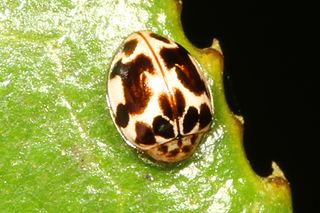
Psyllobora vigintimaculata, the twenty-spotted lady beetle, is a species of lady beetle in the family Coccinellidae. It is found in North America.

Harmonia octomaculata is a species of ladybird of the family Coccinellidae. It is found throughout India, Pakistan, Nepal, Bangladesh, Sri Lanka, Micronesia, and Australia.

Henosepilachna argus, common name bryony ladybird, is a species of beetle in the family Coccinellidae.



















